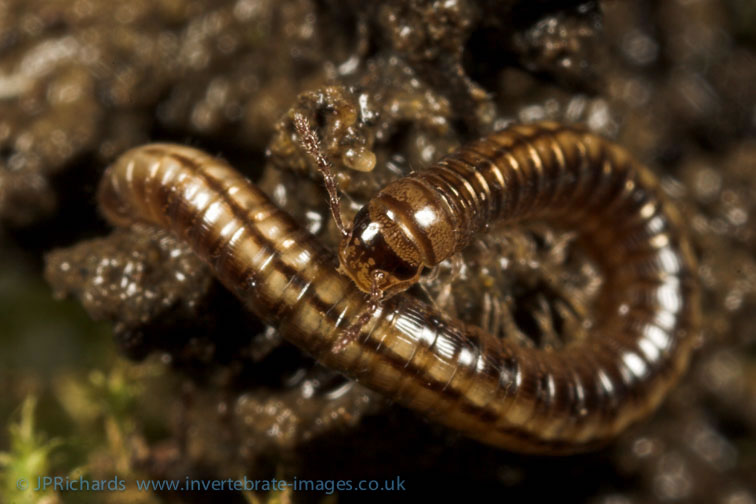Brachyiulus pusillus (Leach, 1816)
Synonyms
Authority previously incorrectly given as Leach (1814) - see Barber & Read (2023).
Status:
GB IUCN status: Least Concern
ID Difficulty
3
Identification
A small brown species (to 10mm length) with two pale yellow stripes running along the upper surface of the body. Confusion is most likely with small immatures of Tachypodoiulus niger or Ommatoiulus sabulosus (which both have a similar striped appearance), but both these species have a prominent pointed projecting telson.
The recent discovery of Brachyiulus lusitanus (and possibly of Brachyiulus cf bagnalli) means that the gonopods of mature males should be examined to be certain of the identification. The former is known from a single site in Cornwall, but both may be over-looked elsewhere in Britain and Ireland.
Figures of male gonopods of these three Brachyiulus species are given in Korsós & Lazányi (2020); pages 95-97.
Distribution and Habitat
This species is widespread across Britain and Ireland. Blower (1985) shows records for vice counties 96, 97, 98 and 104 in NW Scotland. These were listed but not mapped in the preliminary atlas (British Myriapod Group, 1988) and are not mapped here as precise grid references were not available.
Brachyiulus pusillus is also widespread in Europe, although Kime (2004) noted that some of the eastern records may refer to another species, B. bagnalli Brölemann, 1924. Brachyiulus pusillus has been introduced to North and South America, South Africa and many of the Atlantic islands (Blower, 1985).
Habitat
The species appears to become increasingly coastal further north in Britain but also shows a strong association with cultivated sites and grasslands at inland locations in the south. Gregory and Campbell (1996) noted it was typical of river-side meadows in Oxfordshire. Analysis of the recording scheme habitat data suggests a strong negative relationship with woodland, something which Kime (2004) has noted in Belgium along with an association with pastures and agricultural land. Analysis of the soil data suggests a strong association with clays but a negative relationship with loams. Jeekel (2001) linked the species with humid, clayey soils in the Netherlands and suggested it could survive periodical inundation.
Phenology
Adults have been collected throughout the year but records are most frequent in the spring between March and June. Both sexes probably die after breeding (Blower, 1985) in the spring.
This species account is based on Lee (2006).
Links
MilliBase - Global catalogue of Millipedes: https://millibase.org/aphia.php?p=taxdetails&id=151196





